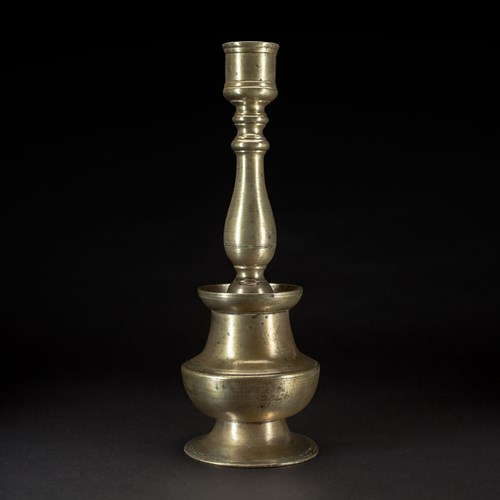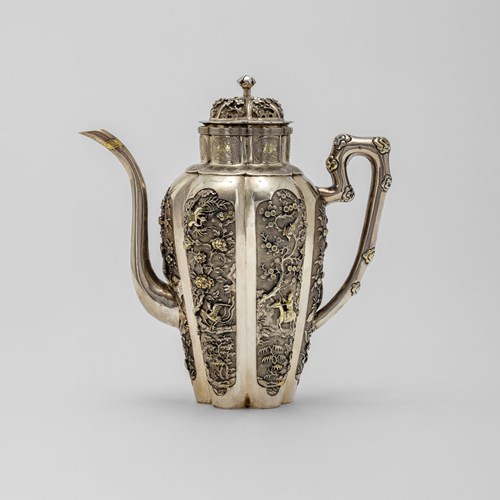A Study of a Male Asian Emerald Dove, Chalcophaps indica
Date c. 1800
Period Early 19th century
Origin India
Medium Watercolour on W Elgar paper
Dimension 45 x 34 cm (17³/₄ x 13³/₈ inches)
-George Edwards, 1743.
With an air of intelligence and grace, a male Asian Emerald Dove perches on a branch. This exceptionally attractive bird inhabits the forests of Southeast Asia and the Indian Subcontinent.
The bird’s beak is a vivid coral and the keen eyes a rich chestnut. The feathers on the crown are white, interspersed with blue flecks. The breast is a rich mauve, suffused with oranges, browns and purple tones. The wings and back plumage form a sublime tapestry of emerald greens with hints of citrine, evoking the myriad shades of the bird’s forest habitat. A small cluster of white feathers appears on the ridge of the wing, while the secondary wing feathers are olive and bronze. The elegant tail feathers are greyish white, tipped black, and the legs and feet are a dusky mauve.
The eighteenth-century English naturalist George Edwards was particularly taken by this species, which he referred to as the "Green Wing'd Dove" in A Natural History of Uncommon Birds, 1743. He remarked that as the bird’s wings caught the light, he witnessed a “splendid Copper Colour, or a Colour more inclining to Gold.” Edwards had sketched an emerald dove at the house of John Warner, a merchant in Rotherhithe. He was also fortunate to have seen another live bird, kept by the naturalist Sir Hans Sloane, 1st Baronet PRS (1660-1753). Sloane’s extraordinary collection of 71,000 items was donated to the Natural History Museum, British Museum and British Library in London, forming the foundations of these important archives.
Displaying such an exquisite array of sublime colours, it is likely Lord Valentia would have delighted in including this bird in his ornithological collection.
For additional ornithological studies made for Lord Valentia, see Sotheby’s Sven Gahlin Collection Lot 36 a drawing of a bustard, and Lot 37 a watercolour of a crow-pheasant, both made for Lord Valentia; Sotheby’s, London, 31 May 2011, The Stuart Cary Welch Collection, Part Two, lot 115; see also Welch 1976, no.26; Welch 1978-I, nos.18a-c.and Leach 1995, no.7.96, pp.760-2. For two bird studies donated by Viscount Valentia to Lord Wellesley, see British Library in London (Wellesley Collection, NHD 29, vol.iv, f.21,27)
Literature
Bikram Grewal et al. 2016. Birds of India - A Pictorial Field Guide. Om Books International.
George Edwards. 1743. A Natural History of Uncommon Birds. The College of Physicians, London.
Stock no.: A5489
Date: c. 1800
Period: Early 19th century
Origin: India
Medium: Watercolour on W Elgar paper
Dimension: 45 x 34 cm (17³/₄ x 13³/₈ inches)
Provenance:
It is highly likely that the work was commissioned by George Annesley, 2nd Earl of Mountnorris and Viscount Valentia (1769-1844), during his visit to Calcutta in 1803. Appearing on the current work, A Study of a Pair of Sunbirds and A Caspian Tern, the ink used on a small stamp on the recto left-hand side exactly matches that used for Viscount Valentia’s personal seal on four other works in the present collection; see An Ashy Drongo, A Bronzed Drongo, A Crimson-Browed Finch and A Small Buttonquail.
George Annesley, 2nd Earl of Mountnorris and Viscount Valentia (1769-1844), was a passionate amateur naturalist with a particular interest in ornithology. Following a career in the army, he travelled to India in 1802 where, inspired by his encounters with professional botanists and zoologists, he commissioned a number of natural history paintings.
During his four-month residency with Saadat Ali Khan, Nawab of Oudh (r. 1798-1814), the Viscount was much enthused by the ruler’s additions to his ornithological collection; “he sent people into his woods to bring me rare birds and plants; he laid a dawk two hundred miles to bring them down to me in a state of perfection.” (Viscount Valentia, 1809, p. 172.)
In 1803 he stayed with Lord Wellesley (the elder brother of the first Duke of Wellington) and visited his menagerie in Barrackpore, Calcutta. Viscount Valentia gifted Wellesley two bird studies from his collection, now in the British Library, London (see M. Archer, Natural History Drawings in the India Office Library, London, 1962, p. 96). The works bear his personal Indian seal, “The Right Honourable Lord Bahadur Viscount Valentia.”
Returning to England in 1806, the Viscount became a member of parliament and wrote a three- volume series chronicling his travels, Voyages and Travels to India, Ceylon and the Red Sea, Abyssinia and Egypt in 1802-06. Published in 1809, the books were illustrated by his draughtsman and secretary Henry Salt. Continuing his interest in the natural world, Annesley became a member of the Royal Society and subsequently his collection has become the subject of an important series of natural history studies, celebrating India’s rich ecological biodiversity.
Of the current series of paintings, four bear the Viscount’s personal Indian seal, “The Right Honourable Lord Bahadur Viscount Valentia 1217 (1802-3)”, while three others have a seal in exactly the same ink as the works with a personal seal. Considering this and that the paintings display such a great likeness to one another, it is highly probable that they were commissioned by the Viscount and undertaken by the same artists. Drawing upon Mughal traditions of exceptionally intricate detail, rich colouration and masterful observation, Viscount Valentia’s artists successfully united this with European scientific taxonomy; achieving a sense of harmony between the romantic and the rational. Charming, informative and highly decorative, these works are a valuable example of the finest early nineteenth century Indian ornithological painting.
Literature
George, Viscount Valentia, 1809. Voyages and Travels to India, Ceylon and the Red Sea, Abyssinia and Egypt in 1802-06. Volume 1, William Miller, London.
Mildred Archer, 1962. Natural History Drawings in the India Office Library, London.
More artworks from the Gallery









